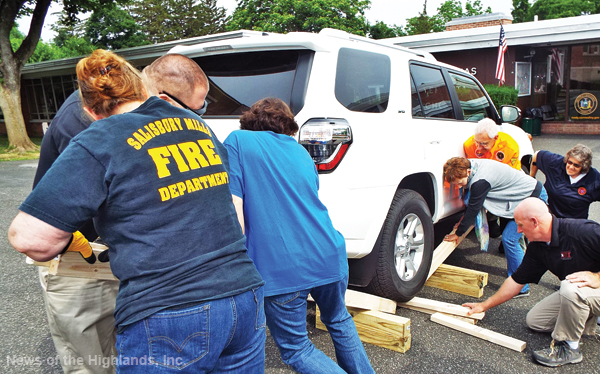

Using two lever and fulcrum systems, class members raised the back tire of this SUV so they could slide two 2x4s underneath it.
What you learned in science class could help save your life.
On Friday and Saturday, two instructors from Texas A&M University presented a 12-hour course, titled “Search & Rescue in Community Disasters,” explaining how to react in the first few minutes, hours, and days of an emergency.
The class, funded by Homeland Security through the Federal Emergency Management Agency (FEMA), drew about 20 members of the public including first responders, physicians, nurses, Boy Scouts, and FEMA representatives.
On Saturday morning, using a system of levers (handles) and fulcrums (a pivot on which a lever rests), participants learned how to lift a heavy object off a person.
Before going outside the St. Thomas of Canterbury School gymnasium, instructor Barry Larsen showed a photo of a typical living room and asked the attendees what could be used as a potential fulcrum. Suggestions included a chair, couch, table, logs in a fireplace, books, bookcase, and a rolled-up rug.
He then asked the “students” to identify possible levers such as a curtain rod, couch, table top, shelf, or lumber from the house. Larsen advised if the wood doesn’t pull out easily, leave it alone as it’s likely holding up something else.
A video showed a woman trying to free her husband, from underneath a couch, after a tornado strike. She placed a chair as close to the couch as possible, using it as a fulcrum. A curtain rod served as the lever to lift the couch enough for her spouse to slide out.
Though lifting a couch doesn’t seem difficult, Larsen said tornadoes bring rain and a couch soaked with water can be fairly heavy.
Larsen then had the class practice their rescue techniques by having them lift the back tire of a Toyota 4Runner enough to slip a 2×4 underneath it.
In the event of an emergency, Larsen said, someone needs to step up and take charge. The person in charge keeps things moving and safe, asks for opinions, gathers information, and then executes a plan.
The Boy Scouts took first crack at the SUV. Stacking 4x4s between the two passenger side tires and using a 2×4 as a lever proved to be unsuccessful. Then they tried lifting the car from the rear, but they scrapped that idea when the lever started to crack.
A group of adults had another idea. They created two lever-fulcrum systems on the front and rear of the tire and successfully lifted the vehicle twice to raise it up on two 2x4s.
“What the levers and fulcrum do is allow us to gain a mechanical advantage,” Larsen said. “Say your house has been hit by a tornado and there are all sorts of stuff flying around. We routinely find people trapped under furniture, heavy objects such as a refrigerator or the roof. As part of self rescue, we teach how to use things inside a house as tools so [people] can help rescue their own family, friends, or neighbors who may be trapped after a disaster.”
Larsen said the course enables members of the public to help in an emergency when first responders are not available.
Following the exercise, the students were back in the gymnasium to learn what to do once individuals are free from any fallen debris.
